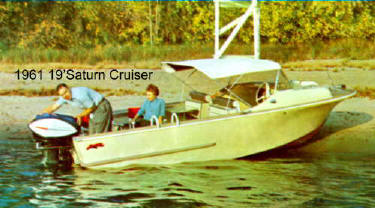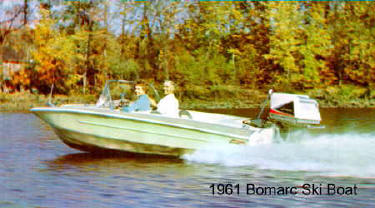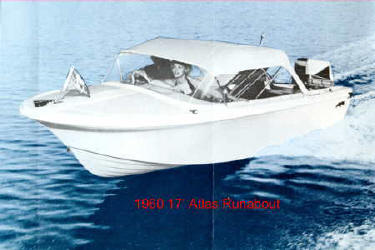by Lee Wangstad
It all started a month ago. I had been visiting www.fiberglassics.com and had taken an excursion into the Mystery Boats section. This is definitely my favorite area of the site. People in need of more information about their boat send in photographs of whatever boat they own, or are possibly looking to buy. Kelly Wood, amiable webmaster of the site then posts the photos and assigns a number in hopes of a reply from someone who can shed any light on its identity. This is where the weird stuff shows up. Mystery Boat #37 was accompanied by a plea on the message board from a frustrated owner that had just run out of places to turn for information. He loved his boat, had already initiated his restoration, but was lacking many details as to hardware, lineage, just what in Heaven’s name was it and where did it come from? As I looked at the picture of the small (14′) runabout, there was something very familiar about it, but I just didn’t have a very strong grasp of what it was.
 A couple of days after I had first viewed this boat on the Fiberglassics site, the owner posted another message stating that he had peeled a label off of the steering wheel and underneath was the name “Jet Stream”. Sure enough, looking through the collection of brochures that Bob Speltz had given me, I had two brochures, one from 1960 and the other from 1961, covering the complete line of Jet Stream boats.
A couple of days after I had first viewed this boat on the Fiberglassics site, the owner posted another message stating that he had peeled a label off of the steering wheel and underneath was the name “Jet Stream”. Sure enough, looking through the collection of brochures that Bob Speltz had given me, I had two brochures, one from 1960 and the other from 1961, covering the complete line of Jet Stream boats.
On the second page of the 1961 literature was the match for Mystery Boat #37, the Jet Stream Bomarc. The Bomarc, a small sports runabout cut low and close to the water, was definitely the hot boat of the lineup. The pictures in the folder showed the boat with a 1960 Evinrude 75hp fat four, a lot of engine for such a small boat.
What caught my interest was that this company was in the process of expanding from 1960 to 1961, and then the information stopped. Had they been bought out? Swallowed up by a merger? It didn’t make much sense to me. But what really aroused my curiosity was a small line at the bottom of the last page of the 1961 catalog that stated: “Manufactured By Red Wing Fiberglass Products Co., Red Wing, Minnesota”.
 To me, this meant that my involvement would run deeper than just copying the information and forwarding it off in the mail to an anxious owner. Telling myself that I would have to pursue this at a time more convenient, I filed the information away.
To me, this meant that my involvement would run deeper than just copying the information and forwarding it off in the mail to an anxious owner. Telling myself that I would have to pursue this at a time more convenient, I filed the information away.
This was another Minnesota boat, which lately have become important to me. While there are those out there I’m sure are waiting for something on Glasspar or Glastron and some of the other “big” national companies, I’m finding that these small regional brands collectively made formidable competition for the name brands that we are perhaps more familiar with.
In the 1961 brochure was a picture of Henry Von Westerhuyzen, “one of America’s top boat stylists and fibreglass fabricators.” I tried to follow up on Henry but to no avail. Then, while doing something that at the time seemed totally unrelated, everything fell together. I was talking with Chuck Meyer, former Sales Manager with Pipestone Sales, manufacturers of Pipestone boats, and he kept referring to Van, who was running the shop at their plant during the late fifties. When I inquired as to who exactly Van was, Chuck dropped the name Henry Von Westerhuyzen!
 Mr. Westerhuyzen had begun his career in the marine industry with Pipestone Sales, located of course, in Pipestone, Minnesota (another story I’ll relate at another time), and while pretty much calling the technical shots, was wanting out and into something where he had more control. This “out” came in the form of an order from Inland Marine of Minneapolis, who wanted an exclusive line of fiberglass boats to sell at their Minneapolis dealership. Inland Marine was carrying a full line of boats that included Century and Larson, and this new line would complement them nicely.
Mr. Westerhuyzen had begun his career in the marine industry with Pipestone Sales, located of course, in Pipestone, Minnesota (another story I’ll relate at another time), and while pretty much calling the technical shots, was wanting out and into something where he had more control. This “out” came in the form of an order from Inland Marine of Minneapolis, who wanted an exclusive line of fiberglass boats to sell at their Minneapolis dealership. Inland Marine was carrying a full line of boats that included Century and Larson, and this new line would complement them nicely.
Dick Tittle, president of Midwest Marine, builders of Mariner Boats and former president of the North Central Marine Association, helped me to get the record straight on Henry’s set up. The Red Wing Development Corporation offered a low interest loan for a building in the newly developed Red Wing Industrial Park. This was the first building to be located in the new park and city fathers were anxious to see something happen. Even with Henry Von Westerhuyzen’s impressive background in the business, the City of Red Wing put a requirement that he have orders for at least 200 boats before they would sign a deal. Inland Marine and Midwest Marine placed the initial orders for the required number of boats to be built at this new plant.
1960, the first year of production for Jet Stream boats saw five runabouts based on two hulls, 15′ and 17′ in length, along with three fishing boats. The 15′ boats were the Titan Series, featuring the Ski-About and the Runabout. The Runabout came equipped with back to back seating and a canvas top, while the Ski-About was more spartan in appointments. The 17′ boats were the Atlas Series, with the Ski-About, Ski-About Deluxe, and at the top of the line the Atlas Runabout. Maximum horsepower ratings for the Titan boats was 60hp and the Atlas series could handle 80hp.
Easily traceable to their Pipestone heritage, they had a somewhat “cleaner” appearance in their styling than the Pipestone boats. Another departure from the Pipestone boats was the hull. The new Jet Stream hull featured a lapstrake fore-foot (front 1/3 of the hull) combined with a smooth hardchine planing area which would assure the lucky owner of a “Jet-O-Way start, fast planing, clean running, greater load carrying capacity, as well as comfort and safety on turn.” How could you even consider anything else?
In 1961 these boats were joined by the 19′ Saturn Cruiser as the new flagship of the line, and the Bomarc, aimed directly at the go fast-feel young market. Another addition in 1961 was a sailboat, a small 15 footer built for inland waters.
As witnessed by other boat manufacturers, growth creates an insatiable appetite for capital. The Industrial Development Corporation was able to front enough money for two building expansions, but more working capital was necessary if Jet Stream was going to make any significant improvements in production.
Just as a Twin City brokerage house was about to make an initial offering of Jet Stream stock, the federal government clamped down on these risky investments. Looking elsewhere for investors, Henry Von Westerhuyzen made some difficult choices in looking for cash backers.
What you have to understand is that Henry was a technical person. He understood the fiberglass technology as well as anyone else in the business at that time. He had his own ideas, his own way of doing things. Up until then he had been in complete control. He found out what many in the same position in the marine market had learned before him: while the influx of cash from outside sources may be sweet, the compromises involved in policy can be bitter.
With his energies focused on increased production and new technology, the business end of the operation was collapsing around him. The FBI became involved in an investigation of his new partner. While this partner was later acquitted, it would force the sale of the plant and end the production of Jet Stream boats.
The publicity surrounding the case left Red Wing in shock. Frustrated beyond hope, Henry Von Westerhuyzen left the marine business forever, later retiring to Florida, where he passed away.
Today his boats live on. If Henry was still with us, he would be amazed to see photographs of his boats being launched from these mystery pages, far out in cyberspace, a place where unknowns linger, searching to find their lost identity. Unlike so many unclaimed and forgotten memories, these mystery boats have new meaning, they are important, they are alive.

